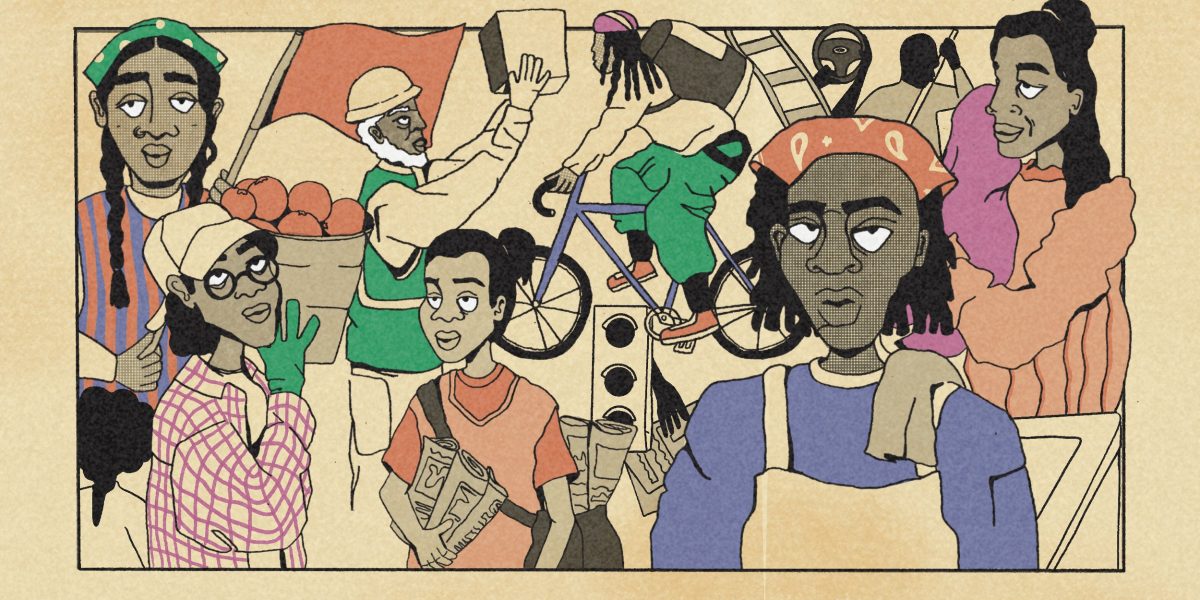Moe Pramanick is a Sindhi-Bengali visual artist based in Toronto. Spring Magazine caught up with Moe to discuss the role of art in movements, and the revolutionary art practices that inspire her work.
You have designed this year’s Mayworks poster titled “All in this together.” What is the concept behind the design ?
Moe: What I was trying to do was create a portrait of migrants and immigrant labour specifically. I pulled the experiences of my own family and friends and people who I know and grew up with, who were largely working immigrant women. I was raised by a single mom who immigrated here from India. Watching her work throughout my childhood to support my sister and I really informed my perspectives on labour and what labour justice looks like.
Originally, the direction I was going in was a bit different. One of the themes that Mayworks proposed for the festival this year was migrant labour. Because I work at FoodShare, which is a food justice organization in Toronto, most of the experiences I have with people I work with are with farmers and farm workers. But when we fleshed out the idea, it felt really important to show the different types of labour that migrants really participate in. I think for a lot of people, when they think of migrant labour, there’s a tendency to romanticize being with nature and farming and all of that stuff, whereas migrants make up so many different parts of the workforce. Migrants and immigrants are literally in every part of running our society.
How do you see art playing a role in advancing workers’ movements?
Moe: Since I grew up in Toronto, I’ve been able to witness so much organizing happening in the city. I’m not exactly sure that I think of art as activism. I think it definitely plays a really important role. For me, working towards a different type of future is being able to visualize it. And I get to do that through art making. But at the same time, as someone who wants to see our city changed, and our world changed, I am always pushing myself to not stay in the abstract or the academic or on the page. Art making is actually a very isolating practice sometimes. I think change, and movements, happen with other people when you’re organizing. I definitely think art is important to movement building and movement work, but I think it’s important to push beyond that.
Where do you get inspiration for revolutionary art and aesthetics?
Moe: Stylistically, I was really inspired by the revolutionary nature of protest posters, specifically throughout history and around the world. For example, Emory Douglas from the Black Panthers in the 70s. I feel like those illustrations are really so prolific. I was also looking at this other art ensemble Medu Art Ensemble that came up in the 80s during South African apartheid. They had a lot of really amazing protest posters during that time. Recently, I went to this art exhibit in New York City where they had posters from community gardens from the 90s and the exhibition was making a commentary on the political history of community gardens and public space in New York.
With all of those posters, I feel like there’s always that sort of rough-around-the-edges, comic art adjacent aesthetics which I really appreciate. I just love comics and I think it’s always been a marker of “cool” for me. When I grew up, my sister and I listened to hip hop and the album covers of MF Doom and Madlib and Wu Tang would always have those comic book style persona on their album art. So the combination of all of that inspired the direction I wanted to go with my poster for Mayworks Festival.
Mayworks Festival of Working People and Arts offer free events during the entire month of May in Toronto and Hamilton. Check out their full programming here.
Did you like this article? Help us produce more like it by donating $1, $2, or $5. Donate

